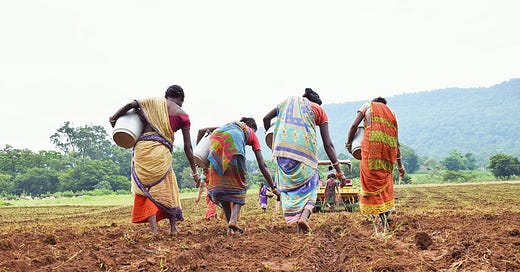Food Prices; Lines from Goa
No Interest in Food Prices?
An Indian farm - image from CIMMYT
Low economic growth and high food prices are the essence of RBI’s interest rate dilemma.
In the simplest telling of interest rate policy, lowering rates boosts economic growth, but encourages inflation. With food prices showing no signs of abating, the monetary policy committee (MPC) of our central bank is reluctant to cut interest rates, despite economic growth that is well below its own expectations.
Calling for lower interest rates, Union Minister Piyush Goyal* said the supposed link between interest rates and food prices is an “absolutely flawed theory”, as food prices are driven by supply and demand. He is right - all prices, not just food prices, are driven by supply and demand. This is Econ 101, but most economics classes will also tell you that monetary policy influences demand. Lower interest rates drive higher money supply, creating more demand. It is this dynamic that has made the RBI hesitant to lower interest rates.
Not that lower interest rates will automatically inject growth back into the Indian economy. Ever since the tax cuts of 2019, Indian corporates are sitting on fat balance sheets, and have never been less dependent on borrowing to fund investment. If they are not investing, it is because demand is slowing, while prices, particularly of food ingredients, are surging.
Wheat prices**, to take an example I am familiar with, have been soaring this year. By Diwali, wholesale prices in Delhi had hit Rs. 3,200 per quintal, a whopping 40% above the price of Rs. 2275 at which the Food Corporation of India bought wheat from the farmer in the April-May harvest this year. Prices would probably have risen further, but the government decided - against its stated policy - to release buffer stocks to bakers and flour-millers.
India’s wheat farmers have been the most visible sign of success of the Green Revolution, and our crop yields, of about 3.4 tons per hectare, are on par with leading wheat-growing nations, like Canada and the US. But there is something severely wrong with our cost and pricing mechanics. You can buy wheat on global markets at 5.6 USD per bushel, which translates to Rs. 17.50 per kg., a little over half the price in Indian markets today.
But if you look at pulses, the dals that are a staple of most Indian meals, productivity is a major issues. Our farmers manage to grow only 770 kg. per hectare, against a global average of 1000 kg. No wonder that we need to import about 15% of our consumption. Canada, which accounts for a quarter of these imports, has a yield of 1860 kg./ha.
Edible oils*** are probably the most egregious example of a food policy gone horribly wrong. Our groundnut farmers, to take one example, grow 1780 kg per hectare, while Chinese farmers weigh in at 4130, and US growers at 4500. Almost two-thirds of the oil in which we cook our food is imported, and this has been a growing concern ever since I sold Dalda for Hindustan Lever in the late 1970s. For the last few decades, our main import has been various varieties of palm oil, from Indonesia and Malaysia. Now, Indonesia has restricted exports, so it can produce more bio-diesel, pushing up global prices. Meanwhile, our government has increased import duties, to encourage domestic production of edible oils.
In the absence of any other cogent initiatives to boost agricultural productivity, this is probably a good thing, but the double whammy has knocked a hole in family budgets, as well as the costing sheets of food manufacturers. Six months ago, you could reckon on edible oil prices of about Rs. 80 per kg. Today, 120 is a realistic budget number to work with.
Mr. Piyush Goyal is right - the huge holes in Indian agriculture have little to do with interest rates. But no one - not he, and not the pink papers, which are equally fixated on interest rates - is talking about the problems of Indian agriculture.
Our most significant food policy initiative of the last few years has been free cereal for 800 million people. Handing out is easy; taking back is tough. Farming is a tough occupation, particularly for small and marginal farmers. If food for subsistence is no longer an issue, families with small holdings may be tempted to give up the ghost altogether. This would not be a welcome development - rising food prices are a clear signal that we need more food supply, not less.
*Piyush Goyal on interest rates:
**High wheat prices:
***Palm oil imports:
Tourism, Yesterday
Image generated with Nightcafe
A bedroom slipper, soft fluffy white
A Radisson tag saying you have arrived
Washed up on a morning shore
Smudged with sand.
A sodden cap called Tommy Hilfiger
Made in Bangladesh
Laundered, hanging
In my balcony.
A whining jet-ski, thumping on the swell
Whiffs of petrol on the breakers
Ridden by a Russian
His taut belly pink with days of sun
Sun worship done, shacks empty at dusk
Candles flicker at lonely tables
Maybe Abba will work
We leave to hear the waves
Bad music is timeless




